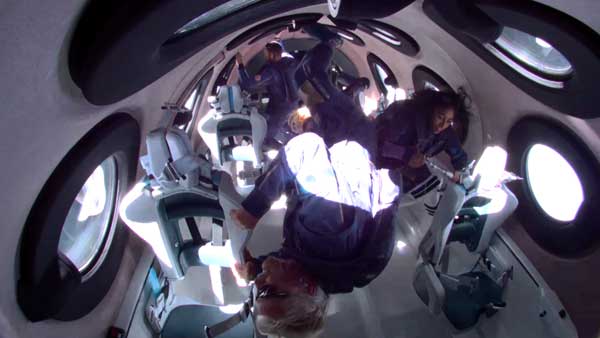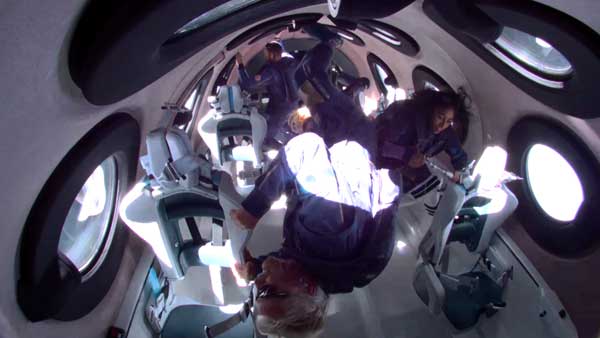
Report: Branson’s Flight into Space Experienced Serious Anomaly; Company Fired Flight Test Director (Image Credit: SNN)
by Douglas Messier
Managing Editor
By all appearances, Richard Branson’s 17-years-in-the-making flight to the edge of space went exactly as planned on July 11. Or at least that was the impression left by Virgin Galactic’s webcast of SpaceShipTwo VSS Unity’s flight test from Spaceport America in New Mexico.
But, for the second time in four suborbital flights, VSS Unity experienced a serious anomaly. The ship with its hybrid engine firing wasn’t rising steeply enough as it soared toward space, Nicholas Schmidle reports in The New Yorker:
Although [pilots David] Mackay and [Mike] Masucci attempted to address their trajectory problem, it wasn’t enough. And now they were accelerating to Mach 3, with a red light glowing in the cockpit. Fortunately for Branson and the three other crew members in the back, the pilots got the ship into space and landed safely. But data retrieved from Flightradar24 shows the vehicle flying outside its designated airspace. An F.A.A. spokesperson confirmed that Virgin Galactic “deviated from its Air Traffic Control clearance” and that an “investigation is ongoing.” A Virgin Galactic spokesperson acknowledged that the company did not initially notify the F.A.A. and that the craft flew outside its designated airspace for a minute and forty-one seconds—flights generally last about fifteen minutes—but said that the company was working with the F.A.A. to update procedures for alerting the agency.…
So, it was a red light. They have those in cars; check the engine or the oil. Well, this one was in a rocket plane and far more serious.
This was a big deal. I once sat in on a meeting, in 2015, during which the pilots on the July 11th mission—Dave Mackay, a former Virgin Atlantic pilot and veteran of the U.K.’s Royal Air Force, and Mike Masucci, a retired Air Force pilot—and others discussed procedures for responding to an entry glide-cone warning. C. J. Sturckow, a former marine and nasa astronaut, said that a yellow light should “scare the shit out of you,” because “when it turns red it’s gonna be too late”; Masucci was less concerned about the yellow light but said, “Red should scare the crap out of you.” Based on pilot procedures, Mackay and Masucci had basically two options: implement immediate corrective action, or abort the rocket motor. According to multiple sources in the company, the safest way to respond to the warning would have been to abort. (A Virgin Galactic spokesperson disputed this contention.)
The story raises, but does not answer, the question of whether Mackay and Masucci didn’t shut down the engine because Branson was aboard. The Virgin Galactic founder had planned to fly on a later flight test, but Branson moved up his flight so he could fly to space before rival Jeff Bezos’ planned suborbital flight aboard Blue Origin’s New Shepard on July 11.
If the pilots had shut down the engine early, VSS Unity would not have exceeded the 50-mile boundary of space recognized by the Federal Aviation Administration. Virgin Galactic wouldn’t have been able to conduct another flight before Bezos flew on July 20, leaving Branson as the runner up.
Branson denied he had changed the schedule to beat Bezos to space, a claim that was widely dismissed amid derisive comments that the two billionaires were engaged in a dick measuring contest. A source told Parabolic Arc, which broke the story of plans to move up Branson’s flight, that is exactly why the schedule was changed.
So, Virgin Galactic conducted a flight test and found an anomaly. That’s why we test, right?
Yes. Absolutely. However….
The flight had Virgin Galactic’s billionaire founder aboard. And the company put him on an earlier flight so he could beat a rival billionaire to the edge of space. Branson is known for taking a lot of physical risks; his latest autobiography, Finding My Virginity, includes an appendix with 75 incidents during which he could have died.
So, there’s no question he was fine with risking his life; the question is why Virgin Galactic management thought it was a good idea to risk losing someone so important. Flight tests are inherently risky; they are designed to find flaws and problems before you put a vehicle into commercial service.
Just as concerning is what the article revealed about the firing of Mark Stucky, who had been Virgin Galactic’s lead pilot and director of flight test. Stucky had been the main subject of Schmidle’s book, “Test Gods,” an inside look at Virgin Galactic that was published in May. Virgin Galactic is very concerned with its image and how it reflects on the larger Virgin Group. And it seems Stucky had been a bit too candid about problems at Branson’s space tourism company.
After the publication of my book, in May, Stucky was stripped of his flight duties and excluded from key planning meetings ahead of the July 11th event. He watched Branson’s flight from the runway; it was the first mission for which he had no responsibilities after more than a decade on the program. Eight days after Branson’s flight, an H.R. manager booked time on his calendar, and then fired Stucky over Zoom.
Getting fired is bad enough; getting fired by an H.R. rep is uber humiliating. Someone above Stucky on the org chart couldn’t have done it? The man had worked there 10 years.
Still, it couldn’t have come as a complete surprise; the company had stripped Stucky of his responsibilities two months earlier, and it likely kept him around to prevent his departure from raising questions about Virgin Galactic’s safety culture and Branson’s upcoming flight. His firing got minimal attention in the wake of that launch.
There have been questions about SpaceShipTwo’s safety culture ever since Virgin Galactic and Scaled Composites announced the program in 2004. Four people have died in two separate accidents, there have been at least four close calls, and safety officials have come and gone with regularity. The most recent departure was Vice President of Safety Todd Ericson, who lost confidence in the company’s safety culture after VSS Unity‘s near-fatal second suborbital flight n February 2019.
A full accounting of these matters is a subject for another day. Suffice to say, nothing I read in the article surprised me. It highlighted issues with the company that I had known about since before the fatal crash of VSS Enterprise in October 2014 that killed Scaled Composites pilot Mike Alsbury and delayed commercial flights by almost eight years.
NewsRead MoreParabolic Arc
– Advertisement –








